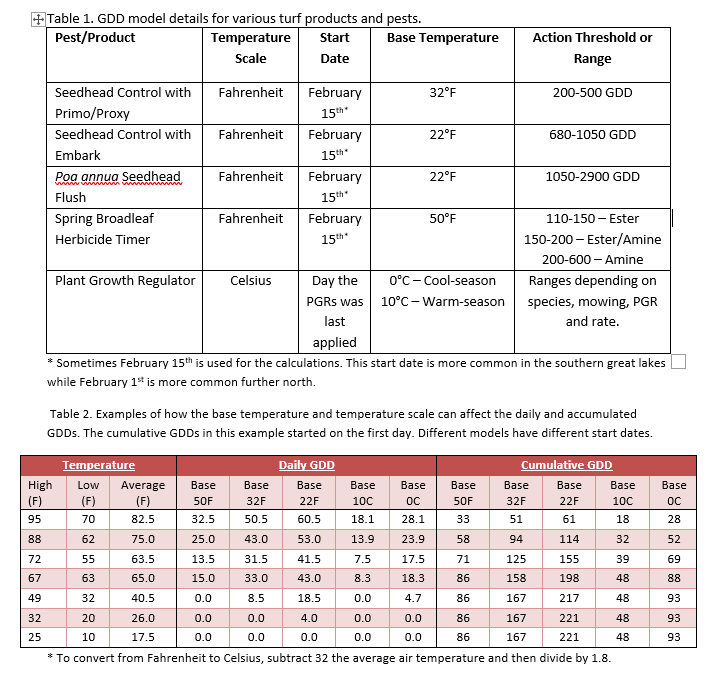By Bill Kreuser, PhD
For twelve years now, I’ve been talking and writing about using growing degree day (GDD) models to schedule plant growth regulator (PGR) applications. But GDD models have many other uses in turf management. For example, there are models to predict when to apply products for Poa annua seed head control, GDD models to predict when to apply early season DMI fungicides for dollar spot control, and models for insect emergence and control.
There are subtle differences between the many different GDD models found in turf. It’s important to understand these differences because they can be the difference between a model working great and being a massive failure.
What are growing degree days?
A growing degree day model is a way to track the accumulation of heat. Plants are cold-blooded like reptiles. Their biology, growth, and development is highly dependent on temperature. The classical example is corn development. Corn growth rate will increase as the average air temperature increases, up to 86°F. When the average air temperature is below 50°F, there is little new corn growth and development. By tracking the amount of heat accumulated (GDDs), farmers can estimate the corn’s growth stage.
The daily GDD is calculated as the average air temperature minus a base temperature where metabolism is minimal. Those daily GDD values are then added together to get the cumulative GDD, which is correlated to plant growth, or insect/weed emergence, or even the amount of PGR remaining in a turfgrass plant.

Different Factors to Consider
While the calculation is fairly straight forward, there are big differences between GDD models. Users need to understand these subtle differences for the models to work correctly:
Temperature scale:
Most GDD models use degrees Fahrenheit (°F), but PGR models in turf use degrees Celsius (°C). Using °F for PGRs will result in too frequent of PGR applications. This wastes money and leads to over-regulation.
Model Start Date:
This depends on the model. For PGR modeling, the model starts the day the PGR is applied. It is reset to zero the next time the PGR is re-applied. For predictions of emergence (i.e. seed head treatment/emergence, insect treatment) it is important to know the start date. Some models start on January 1st while others start on February 15th. This difference can have big impacts on the success rate of a GDD model.
Base Temperature:
It is essential to use the correct base temperature and associated temperature unit (°F vs °C). For PGR models, the base temperature is 0°C for cool-season turf but 10°C for warm season turf. The base temperature is 32°F for Poa annua seed head control with Proxy while the seed head flush model uses a base of 22°F.
Action Thresholds:
All GDD models are just numbers unless there is some level of interpretation included with the number. The action threshold is the GDD when something is likely to occur or something needs to be done. For example, the PGR Primo Maxx needs to be applied every 200 GDD (base 0°C) to sustain yield suppression on a creeping bentgrass putting green but 300 GDD when applied to a creeping bentgrass fairway. It’s also important to know where action threshold was developed. The action thresholds may vary if a model is used outside of the region where it was developed. The PGR models have been verified across the country, but some models (i.e. seed head control thresholds) may have a slightly different threshold in another region.
GreenKeeper App Automatically Calculates GDDs
GreenKeeper was originally built specifically to track PGR GDDs. As our research knowledge has grown, the complexity of these models within GreenKeeper has also expanded. Today there are over 600 different PGR GDD models in the GreenKeeper system. These models are specific to grass species, PGR ingredient(s), and mowing height and scale depending on PGR application rate. The cool-season models use the base 0C scale while the warm-season models use the base 10C GDD scale. Everyday GreenKeeper downloads the prior day’s weather observation and forecast for all the courses in the database to recalculate the PGR GDDs and project when the PGRs need to re-applied.
In the spring of 2020, the Environmental Models dashboard was released. This dashboard tracks GDD and other types of models that help guide agronomic decision-making. The first model released was the First Spring Ethephon Application Tracker. This model starts on Feb. 15th each year and calculates the GDDs in the base 32F scale – we do show the GDDs using the base 0C GDD scale too. As GDDs are accumulated, the status bar will change color as the target window is approached (green color). The interpretation bar will also provide guidance suggesting that the timing is ‘too early’, ‘apply soon’, ‘target window’, ‘past target’, and ‘too late to apply.’ These models are GreenKeeper Premium features and they can be turned off on the ‘My Course’ page once they are no longer applicable for the year.

This article is a re-print of the turf iNfo article “The Nuance of Growing Degree Day Calculations” from 2 Oct. 2017. It can be found at turf.unl.edu.
